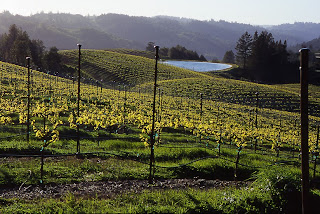Best Supporting Actress 1974
Murder on the Orient Express 1982
A Woman Called Golda Best Actress - Miniseries 1983
A Woman Called Golda Ingrid Bergman (help·info) (pronounced
[ˈbærjman] in
Swedish, but usually
[ˈbɝgmən] in
English,
IPA notation) (
August 29,
1915 –
August 29,
1982) was a three-time
Academy Award-winning and two-time
Emmy Award-winning
Swedish actress. She also won the
Tony Award for
Best Actress in the
first Tony Award ceremony in
1947. She is ranked as the
fourth greatest female star of all time by the
American Film Institute.
Biography Bergman, named after
Princess Ingrid of Sweden , was born in
Stockholm,
Sweden on
August 29,
1915 to a Swedish father, Justus Samuel Bergman, and a German mother, Friedel Adler Bergman. When she was three years old, her mother died. Her father passed away when she was thirteen. She was then sent off to live with an aunt, who died of heart complications only six months later. Afterwards she was raised by another aunt and uncle, who had five children.
At the age of 17, Ingrid Bergman auditioned for and was accepted to the
Royal Dramatic Theatre in Stockholm. During her first summer break, she was hired at a Swedish film studio, which consequently led to her leaving the
Royal Dramatic Theater to work in films full time, after having attended for only one year. Her first film role after leaving the Royal Dramatic Theater was a small part in 1935's
Munkbrogreven (She had previously been an extra in the 1932 film
Landskamp).
On
July 10,
1937, at the age of 21, she married a dentist, Petter Lindström (who would later become a neurosurgeon). On
September 20,
1938, she gave birth to a daughter,
Pia Lindström.
After a dozen films in Sweden (including
En kvinnas ansikte which would later be remade as
A Woman's Face with
Joan Crawford) and one in
Germany, Bergman was signed by Hollywood producer
David O. Selznick to star in the
1939 English language remake of her 1936 Swedish language film,
Intermezzo. It was an enormous success and Bergman became a star, described as "Sweden's illustrious gift to
Hollywood". Some things that set her apart from other female stars in Hollywood at that time were that she did not change her name, her appearance was entirely natural with little to no makeup, and that she was one of the tallest leading ladies.
Early years: 1915-1938 After completing one last film in Sweden and appearing in three moderately successful films in the
United States, Bergman joined
Humphrey Bogart in the 1942 classic film
Casablanca, which remains her best known role.
That same year, she received her first Academy Award nomination for
Best Actress for
For Whom the Bell Tolls (1943), which was also her first color film. The following year, she won the
Academy Award for Best Actress for
Gaslight (1944). She received a third consecutive nomination for Best Actress with her performance as a nun in
The Bells of St. Mary's (1945). Bergman had been considered for the role of Mother Maria-Veronica in 1944's
The Keys of the Kingdom, but the part ultimately went to Rose Stradner, who was then the wife of the film's producer,
Joseph Mankiewicz.
Later, she would receive another Best Actress nomination for
Joan of Arc (1948), an independent film produced by
Walter Wanger and initially released through
RKO. Bergman had championed the role since her arrival in Hollywood, which is one of the reasons she had played it on the Broadway stage in
Maxwell Anderson's
Joan of Lorraine. Partly because of the scandal with Rossellini, the film, based on the Anderson play, was not a big hit, and received disastrous reviews. It was subsequently shorn of 45 minutes, and it was not until its restoration to full length in 1998 and its 2004 appearance on
DVD that later audiences could see it as it was intended to be shown.
Bergman also starred in the
Alfred Hitchcock films
Spellbound (1945),
Notorious (1946), and
Under Capricorn (1949). Unlike her earlier Hitchcock films,
Under Capricorn was a slow-paced costume drama, slow to such a degree that Bergman's reputation and the film's release suffered from this, in addition to the gathering adverse publicity over Bergman's affair with Rossellini.
Between motion pictures, Bergman appeared in the stage plays
Liliom,
Anna Christie, and
Joan of Lorraine. Furthermore, during a press conference in Washington, D.C. for the promotion of
Joan of Lorraine, she protested against segregation after seeing it first hand at the theater she was acting in. This led to a lot of publicity and some hate mail.
Ingrid Bergman also went to Alaska during World War II in order to entertain troops. Soon after the war ended, she also went to Europe for the same purpose, where she was able to see the devastation caused by the war. It was also during this time that she began a relationship with the famous photographer
Robert Capa.
 Hollywood period: 1938-1949
Hollywood period: 1938-1949 In 1949, Bergman met
Italian director Roberto Rossellini in order to make the film
Stromboli (1950), after having been a fan of two of his previous films that she had seen while in the United States. During the making of this movie, she fell in love with him and became pregnant with a son, Roberto Ingmar Rossellini (born
February 7,
1950).
The pregnancy caused a huge scandal in the United States. It even led to her being denounced on the floor of the
U.S. Senate by
Edwin C. Johnson, a senator from
Colorado, who referred to her as "a horrible example of womanhood and a powerful influence for evil." In addition, there was a floor vote, which resulted in her being made
persona non grata. The scandal forced Ingrid Bergman to exile herself to Italy, leaving her husband and daughter in the United States. Her husband, Dr. Petter Lindström, eventually sued for desertion and waged a custody battle for their daughter.
Ingrid Bergman married Roberto Rossellini on
May 24,
1950. On
June 18,
1952, she gave birth to twin daughters,
Isabella Rossellini, who is a famous actress and model, and
Isotta Ingrid Rossellini. Over the next few years, she appeared in several Italian films for Rossellini, including
Giovanna d'Arco al rogo (
Jeanne d'Arc au bûcher,
Joan of Arc at the Stake, 1954), a 1935 dramatic
oratorio by
Arthur Honegger about Joan of Arc. Their marriage ended in divorce on
November 7,
1957.
After separating from Rossellini, she starred in
Jean Renoir's
Elena and Her Men (
Elena et les Hommes, 1956), a romantic comedy where she played a Polish princess caught in political intrigue. Although the film wasn't a success, it has since come to be regarded as one of her best performances.
During her time in Italy, anger over her private life had continued unabated in the United States, with
Ed Sullivan at one point infamously polling his TV show audience as to whether she should be forgiven.
Later years: 1957-1982 Ingrid Bergman died in 1982
on her 67th birthday in
London,
England, following a long battle with
breast cancer. Her body was cremated in Sweden. Most of her ashes were scattered in the sea with the remainder being interred in the
Norra begravningsplatsen in
Stockholm next to her parents. A single violin played the song "
As Time Goes By", the theme from
Casablanca, recalling her most famous role, that of Ilsa Lund.
Death In 1980, Bergman's autobiography was published under the title
Ingrid Bergman: My Story. It was written with the help of
Alan Burgess, who had written the book
The Small Woman, on which the film
The Inn of the Sixth Happiness was based. In the book, she discusses her childhood, her early career, her life during her time in Hollywood, the Rossellini scandal and subsequent events. The book was written after her children warned her that she would only be known through rumors and interviews if she did not tell her own story. It was through this autobiography that her affair with
Robert Capa became known.
Autobiography For her contributions to the motion picture industry, Ingrid Bergman has a star on the
Hollywood Walk of Fame at 6759 Hollywood Blvd. She continues to be a cultural icon - not only for her role in
Casablanca, but for her career as a whole and for her innocent, natural beauty. In addition, she is considered by many to be one of the foremost actresses of the 20th century.
Legacy There is a hybrid tea rose named after her.
Although they worked together, Bergman is not related to fellow Swedish director
Ingmar Bergman. The fact that Ingmar Bergman married
Ingrid von Rosen who subsequently took the name Ingrid Bergman sometimes further contributes to confusion about their relation.
Trivia Awards Chronology of performances Filmography Television credits Theater credits Audio recording credits Radio credits Ingmar Bergman Alfred Hitchcock Gary Cooper Charles Boyer Cary Grant Victor Fleming Humphrey Bogart Yul Brynner See also Notes Bergman, Ingrid and Burgess, Alan (1980). Ingrid Bergman: My Story. New York: Delacorte Press. ISBN 0-440032-99-7. Chandler, Charlotte (2007). Ingrid: Ingrid Bergman, A Personal Biography. New York: Simon & Schuster. ISBN 0-7432-9421-1. Leamer, Laurence (1986). As Time Goes By: The Life of Ingrid Bergman. New York: Harper & Row. ISBN 0-060154-85-3. Biographical profiles Ingrid Bergman website by her family Ingrid Bergman site run by CMG Ingrid Bergman Collection at
Wesleyan University Official sites 1943 New York Times Interview Larry King transcript with Ingrid Bergman's daughters on the 60th anniversary of
Casablanca Excerpt from Isabella Rossellini's Some of Me that describes Ingrid Bergman's passion for cleaning Rich media — video Radio rich media may be found in the radio credits table.
Ingrid Bergman's Spoken Word Version of The Pied Piper of Hamelin Audio Recording of Ingrid Bergman in the NY Production of More Stately Mansions (1967) (
RealPlayer)
 The Indo-Iranian language group constitutes the easternmost extant branch of the Indo-European family of languages. It consists of four language groups: the Indo-Aryan, Iranian, Nuristani, and Dardic. The term Aryan languages is also used to refer to the Indo-Iranian languages . The speakers of the Proto-Indo-Iranian language, the hypothetical Proto-Indo-Iranians, are usually associated with the late 3rd millennium BC Sintashta-Petrovka culture of Central Asia. Their expansion is believed to have been connected with the invention of the chariot.
The Indo-Iranian language group constitutes the easternmost extant branch of the Indo-European family of languages. It consists of four language groups: the Indo-Aryan, Iranian, Nuristani, and Dardic. The term Aryan languages is also used to refer to the Indo-Iranian languages . The speakers of the Proto-Indo-Iranian language, the hypothetical Proto-Indo-Iranians, are usually associated with the late 3rd millennium BC Sintashta-Petrovka culture of Central Asia. Their expansion is believed to have been connected with the invention of the chariot. Buildings
Buildings


 Hollywood period: 1938-1949
Hollywood period: 1938-1949
 History
History Collectable toys
Collectable toys Impact
Impact
 Geography
Geography